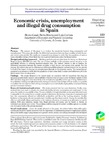Economic Crisis, Unemployment and Illegal Drug Consumption in Spain

Ver/Abrir
Use este enlace para citar
http://hdl.handle.net/2183/27404Colecciones
- Investigación (FEE) [923]
Metadatos
Mostrar el registro completo del ítemTítulo
Economic Crisis, Unemployment and Illegal Drug Consumption in SpainFecha
2020Cita bibliográfica
Casal, B., Rivera, B. and Currais, L. (2020), "Economic crisis, unemployment and illegal drug consumption in Spain", Applied Economic Analysis, Vol. 28 No. 83, pp. 153-170. https://doi.org/10.1108/AEA-07-2019-0014
Resumen
[Abstract] Purpose – The purpose of this paper is to analyse the association between drug consumption and
unemployment. This paper also studies the differential association between these variables in both the preand current-crisis periods. The results are compared in an attempt to verify that the population of users is
more vulnerable in terms of how likely they are to get and hold down a job in the labour market.
Design/methodology/approach – Matching methods and microdata from the Survey on Alcohol and
Drugs in Spain, EDADES are used. The use of these methods on the estimates carried out prove to be
particularly effective in reducing treatment-selection bias. The authors’ interest is also to analyse the
differential association between the interest variables in both the pre- and current-crisis periods. For this
purpose, the authors also use the differences-in-differences (DID) estimation method between the two periods
to check if the impact of drug use on unemployment depends on the economic context. The estimations are
compared in an attempt to verify that the population of users is less likely to attain and hold down a job in the
labour market than non-drug users.
Findings – The results obtained in the current study are consistent with the hypothesis that drug use
decreases an individual’s capacity and availability when he or she is trying to enter the labour market. In both
2007 and 2013, drug users were more likely to be unemployed, regardless of the type of drug. Differences in
the probability of being unemployed intensify during an economic crisis. In light of these results, it is possible
to conclude that the negative effect of drug consumption on an individual’s employability is increased during
periods of economic recession.
Research limitations/implications – The study presented here has some limitations. Firstly, crosssectional data were used to examine the causal relationship between consumption and employment. In this
sense, the results are susceptible to bias. The unavailability of longitudinal data on the same individual made
it impossible for the researchers to consider periods of abstinence, the duration of periods of consumption and
how this consumption affected an individual’s productivity and his or her working situation. Another
limitation is that certain relevant unemployment variables may have been omitted. Among the variables that
affect an individual’s labour participation is the existence of sources of income as an alternative to market
salaries. With state subsidies, income from illegal activities and money sent by family or friends, an
individual may decide not to work. This problem could be mitigated if omitted variables operate in a similar
way throughout both of the periods examined.
Social implications – Given the results obtained in this paper, the authors believe that public policy
conclusions should be mainly concerned with the importance of implementing proactive employment policies,
along with family support programmes and a greater role for primary care among the people with the highest risks of exclusion. Health treatment should go jointly with measures that make it easier for individuals to
enter the workforce. These steps would only be possible with an improved level of education and more
complete professional profiles, to increase motivation when individuals seek employment.
Originality/value – This study could make various contributions to the existing body of evidence. In the
authors’ knowledge, this is the first attempt to document the effect of the economic crisis on the employability
of the drug-using population in contrast with the general population. Moreover, a methodology is presented
that provides an alternative to those used in earlier studies, in terms of reducing treatment-selection bias. At
the same time, the use of a DID estimation method between pre- and current-crisis periods allow us to check if
the impact of drugs consumption on unemployment depends on the economic context.
Palabras clave
Spain
Economic crisis
Unemployment
Drug consumption
Matching methods
Economic crisis
Unemployment
Drug consumption
Matching methods
Versión del editor
Derechos
Atribución 4.0
ISSN
2632-7627






